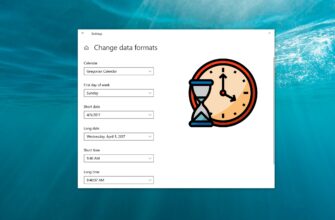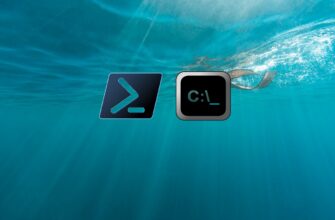Keyboard shortcuts are combinations of two or more keys that you can use to perform tasks that normally require the use of a mouse or other pointing device. Keyboard shortcuts save you time and effort when using the Windows 10 operating system and various applications.
The keyboard shortcuts are listed in the application menus. Most of them also include keyboard shortcuts to make it easier to navigate menus and perform other commands. If a letter or word in a menu is underlined, it usually means that you can press the ALT key and the key corresponding to the underlined letter at the same time to select the menu item. When using the touch keyboard, some keyboard shortcuts are displayed when you press the CTRL key.
Some new keyboard shortcuts have been added to the Windows 10 operating system. This was due to the fact that the operating system has new features and new applications.
The following tables show the keyboard shortcuts in Windows 10 by the main functions they perform: system-wide keys, taskbar application control, window control, virtual desktops, multimedia functions, command line.
| Basic keyboard shortcuts | |
|---|---|
| F2 | renaming the selected item |
| F3 | Search for a file or folder in explorer |
| F4 | display the address bar list in the explorer |
| F5 | update the active window |
| F6 | cyclic switching between screen elements in a window or on the desktop |
| F10 | activating the menu bar in the active application |
| Alt + F4 | triggers the system power menu or closing the active item or exiting the active application |
| Alt + Esc | cyclic switching between items in the order in which they were opened |
| Alt + underlined letter | the execution of the command corresponding to this letter |
| Alt + Enter | display the properties of the selected item |
| Alt + “spacebar” | open the context menu of the active window |
| Alt + ← (left arrow) | back |
| Alt + → (right arrow) | forward |
| Alt + Page Up | move up one page |
| Alt + Page Down | move down one page |
| Alt + Tab | Switching between open applications |
| Ctrl + F4 | close the active document (in full-screen applications that allow several documents to be opened simultaneously) |
| Ctrl + A | select all elements in a document or window |
| Ctrl + C (or Ctrl + Insert) | copy the selected item |
| Ctrl + D (or Delete) | Remove the selected item and move it to the trash |
| Ctrl + R (or F5) | update the active window |
| Ctrl + V (or Shift + Insert) | inserting the selected item |
| Ctrl + X | cut out the selected element |
| Ctrl + Y | repeat action |
| Ctrl + Z | rescission |
| Ctrl + → (right arrow) | move the cursor to the beginning of the next word |
| Ctrl + ← (left arrow) | move the cursor to the beginning of the previous word |
| Ctrl + ↓ (down arrow) | move the cursor to the beginning of the next paragraph |
| Ctrl + ↑ (up arrow) | move the cursor to the beginning of the previous paragraph |
| Ctrl + Alt + Tab | Use the arrow keys to switch between open applications |
| Ctrl + arrow key (to move to an item) + “spacebar” | Selecting several individual items in a window or on the desktop |
| Ctrl + Shift + arrow key | text selection |
| Ctrl +Esc | opening the Start menu |
| Ctrl + Shift + Esc | running the task manager |
| Ctrl + Shift | Switching the keyboard layout if there is more than one |
| Ctrl + “spacebar” | turning the input method editor for Chinese on and off |
| Shift + F10 | open the context menu for the selected item |
| Shift + any arrow key | select multiple items in a window or on the desktop, as well as highlighting text in a document |
| Shift + Delete | Remove a selected item without first putting it in the trash |
| → (right arrow) | opening the next menu to the right or opening a submenu |
| ← (left arrow) | open the next menu on the left or close a submenu |
| Esc | Stop the current task or quit it |
| System-wide keys | |
|---|---|
| Win | Start menu invocation |
| Win + S | Call the Start menu search bar |
| Win + I | Open the “Settings” window of the “Start” menu |
| Win + A | opening a notification center |
| Win + H | Calling the Share menu |
| Win + P | Calling the “Project” menu |
| Win + R | Open the “Run” window |
| Win + “spacebar” | Switching input language and keyboard layout |
| Win + L | Desktop lock |
| Win + K | Connecting to a wireless display or audio device |
| Win + X | Start button context menu |
| Win + D | shows the desktop |
| Win + E | opens the guide |
| Ctrl + Shift + Esc | starting the Task Manager |
| Manage applications on the taskbar | |
|---|---|
| Win + T | Toggle between icons on the taskbar. To launch the desired application you will need to press the Enter key |
| Win + numbers from 0 to 9 | launch the application from the taskbar whose button corresponds to the number (the countdown starts immediately after the Taskbar View button) |
| CTRL + SHIFT + pressing the taskbar button | running the application as an administrator |
| SHIFT + right-clicking the taskbar button | Display a menu window for the application |
| SHIFT + right-clicking the grouped taskbar button | window menu display for the group |
| CTRL + pressing the grouped taskbar button | cyclic switching between group windows |
| Window control | |
|---|---|
| Win + → (right arrow) | fixing the active window on the right side of the monitor screen |
| Win + ← (left arrow) | fixing the active window on the left side of the monitor screen |
| Win + ↑ (arrow up) | Expand the active window horizontally and vertically |
| Win + ↓ (down arrow) | restore the active window (if the window was maximized), or minimize the active window |
| Win + ← + ↑ (left arrow, then press the up arrow) | the active window will be fixed in the upper left corner of the monitor screen |
| Win + ← + ↓ (left arrow, then press the down arrow) | the active window will be fixed in the lower left corner of the monitor screen |
| Win + → + ↑ (right arrow, then press the up arrow) | the active window will be fixed in the upper right corner of the monitor screen |
| Win + → + ↓ (right arrow, then press the down arrow) | the active window will be fixed at the bottom right corner of the monitor screen |
| Ctrl + N | Open a new active window |
| Key combinations in the explorer | |
|---|---|
| Win + E | launch explorer |
| Alt + Enter | open the “Properties” window of the selected file |
| Shift + Del | Deleting a file bypassing the Recycle Bin |
| Alt + D | address bar selection |
| Ctrl + E | selecting a search field |
| Ctrl + F | selecting a search field |
| Ctrl + W | Closing the current window |
| Ctrl + mouse scroll wheel | change the size and appearance of file and folder icons |
| Ctrl + Shift + E | display all folders in which the selected folder is nested |
| Ctrl + Shift + N | create a new folder |
| Num Lock + asterisk (*) | display all folders nested in the selected folder |
| Num Lock + plus sign (+) | display the contents of the selected folder |
| Num Lock + minus sign (-) | Collapse the selected folder |
| Alt +P | displaying the viewing area |
| Virtual desktops | |
|---|---|
| Win + Ctrl + D | Create a new virtual desktop |
| Win + Ctrl + F4 | Closing the virtual desktop |
| Win + Ctrl + → (right arrow) | Switching between the created virtual desktops from left to right |
| Win + Ctrl + ← (left arrow) | Switching between the created virtual desktops from right to left |
| Win + Tab | Open running applications in all created virtual desktops |
| Multimedia functions | |
|---|---|
| Win + Print Screen | take a screenshot, the screenshot will be saved in a specially created folder “Screenshots”, which is located in the “Images” folder |
| Win + G | Opening the Game DVR panel to record video in games (set up in Xbox) |
| Win + Alt + Print Screen | take a screenshot in the game |
| Win + Alt + R | start recording, if pressed again – stop recording |
| Win + Alt + G | recording of the last 30 seconds in the active window |
| Win + P | to switch between displays, if there is a second display |
| Win + «plus» | Magnifying with the Magnifier app |
| Win + «minus» | Reduction with the Magnifier app (Magnifier) |
| Command prompt | |
|---|---|
| Ctrl + C or Ctrl + Insert | Copying a selected test |
| Ctrl + V or Shift + Insert | inserting text at the cursor position |
| Ctrl + M | highlight at the command prompt |
| Ctrl + A | all text in the current line is highlighted, if there is no text in this line, all text in the command line will be highlighted |
| Shift + ← (left arrow) | highlight a single character to the left of the cursor |
| Shift + → (right arrow) | highlight a single character to the right of the cursor |
| Shift + ↑ (up arrow) | highlight a character, and then the whole line up |
| Shift + ↓ (down arrow) | highlight a character, and then the whole line down |
| Ctrl + Shift + ← (left arrow) | select one word that is located to the left of the cursor |
| Ctrl + Shift + → (right arrow) | select one word, which is located to the right of the cursor |
| Shift + Home | moves the cursor to the beginning of the current line |
| Shift + End | moves the cursor to the end of the current line |
| Ctrl + ↑ (up arrow) | move up a line |
| Ctrl + ↓ (down arrow) | move to the line below |
| Ctrl + Page Up | move up one page in the command prompt |
| Ctrl + Page Down | move down one page in the command prompt |
| Ctrl + F | opening a search window on the command prompt |
| Alt + F4 | closing the command prompt |





